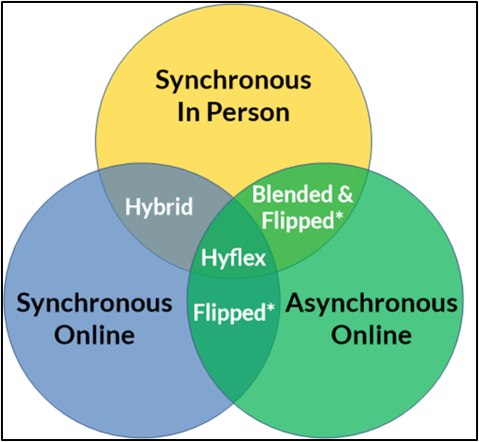This guide will review the different styles of multimodal courses, requirements for success in hybrid or hyflex teaching, and resources to support your exploration and/or implementation of multimodal teaching in your course(s).
Overview of Course Modalities
|
Most courses have both synchronous and asynchronous elements. For example, synchronous online meetings with asynchronous readings, homework, and online discussions.
There are four common terms to describe mixed synchronicity:
|
Related resources:
Why Consider Multimodal Teaching
Allowing students the option of attending class remotely dramatically increases the accessibility of education for sick, working, caregiving, disabled, chronically ill, immunocompromised, geographically distanced, and English-as-a-Second-Language (ESL) students.
Students are given back the time, energy, and money they would have spent getting to class. The reduced requirement for travel or physical presence alleviates financial barriers based on transportation costs, increased housing costs to live on or near campus, and parking permit costs (if applicable). The reduced need for parking on campus reduces competition for parking & gas emissions from the extra cars. The reduced campus traffic probably results in fewer traffic-related injuries, too.
Students who are hard of hearing, deaf, or struggle to understand spoken English benefit from live transcription on Zoom or Teams meetings. Availability of lecture recordings allows students to review the material multiple times at varying playback speeds to meet their needs. Moreover, disconnecting the course activities from a hard schedule of attendance/participation means that students with competing scheduling concerns (caregiving, work, or another class required for graduation offered in the same time slot).
Beyond time and transportation logistics, the mental, emotional, psychological, and physical effort spent on getting to and participating in a physical classroom may also be a limiting factor for some students. The ability to join remotely may be the difference between a student taking 4 classes where they would otherwise take only 2 or 3, which may reduce the time required for them to graduate. Students who might not be comfortable speaking up in a physical classroom sometimes find that confidence in the online environment.
Online teaching definitely comes with its own set of accessibility issues and equity concerns. However, there are undeniable benefits to otherwise underserved students that demand consideration in modern course design.
Related Resources:
Students are given back the time, energy, and money they would have spent getting to class. The reduced requirement for travel or physical presence alleviates financial barriers based on transportation costs, increased housing costs to live on or near campus, and parking permit costs (if applicable). The reduced need for parking on campus reduces competition for parking & gas emissions from the extra cars. The reduced campus traffic probably results in fewer traffic-related injuries, too.
Students who are hard of hearing, deaf, or struggle to understand spoken English benefit from live transcription on Zoom or Teams meetings. Availability of lecture recordings allows students to review the material multiple times at varying playback speeds to meet their needs. Moreover, disconnecting the course activities from a hard schedule of attendance/participation means that students with competing scheduling concerns (caregiving, work, or another class required for graduation offered in the same time slot).
Beyond time and transportation logistics, the mental, emotional, psychological, and physical effort spent on getting to and participating in a physical classroom may also be a limiting factor for some students. The ability to join remotely may be the difference between a student taking 4 classes where they would otherwise take only 2 or 3, which may reduce the time required for them to graduate. Students who might not be comfortable speaking up in a physical classroom sometimes find that confidence in the online environment.
Online teaching definitely comes with its own set of accessibility issues and equity concerns. However, there are undeniable benefits to otherwise underserved students that demand consideration in modern course design.
Related Resources:
- Gannon, K. [Grand View University] (2020). Our HyFlex Experiment: What’s Worked and What Hasn’t. Chronicle of Higher Education.
- Montgomery College. Advantages and Disadvantages of Online Courses
- Cengage Group (2021). Faculty more positive about online learning post-pandemic
- Adams, J (2021) [San Francisco State]. One Student’s View of HyFlex. HyFlex Learning Community.
- Peterson, A. (2021) [University of St. Thomas]. HyFlex Learning from an Undergraduate Student’s Perspective: Positives and Pitfalls. HyFlex Learning Community.
Example Course Designs & Other Guides
- Columbia University. Hybrid/HyFlex Teaching & Learning Instructor Guide
- Columbia University. Five Tips for Hybrid/HyFlex Teaching with All Learners in Mind
- Kevin Kelly, EdD [San Francisco State University]. HyFlex Course Design – Example 50-Min & 75-Min Class Sessions
- Beatty, B. J. (2019). Hybrid-Flexible Course Design: Implementing student-directed hybrid classes. Unit 1, Chapter 4: Designing a Hybrid-Flexible Course.
- University of North Carolina. Hybrid-Flexible (or Hyflex) Implementation Guide
